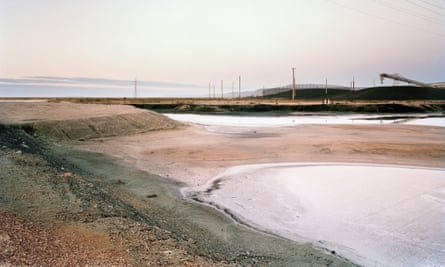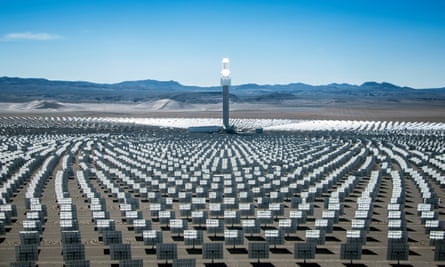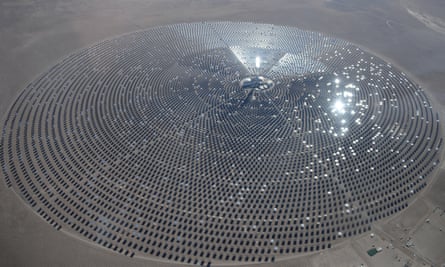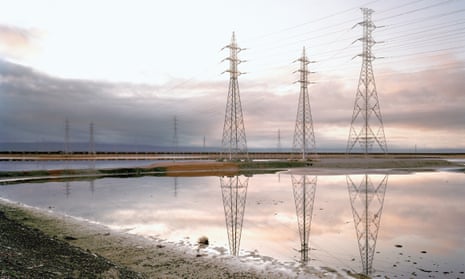Each day a trainload of coal rolls into the South Australian town of Port Augusta, where it is burned and turned into electricity. But these days that coal is shipped from a mine that is no longer digging. It is burned at a power plant that is about to be demolished.
Port Augusta is the fabled canary in the coalmine – a coal town teetering on a precipice as it transitions away from fossil fuels.
One possible future is the town creating hundreds of jobs by building Australia’s first major solar thermal power plant, sucking up the energy of the sun and providing a steady stream of power for southern Australia.
On the other side of the precipice is decline, with the free market left to the decide the fate of the people who live in Port Augusta.
Many factors seem to line up to favour the brighter path: local councillors, residents and anti-coal activists are campaigning for it; there is a state grant that seems almost designed for it; and possible federal interest from Malcolm Turnbull and his new clean energy fund. A US company with experience building solar thermal plants is enthusiastic about a thermal power plant, plus coal power workers and their union are on board with the idea.
As the jostling, lobbying and campaigning carries on, towns around Australia and the world are looking on, hoping Port Augusta can do it. It would give hope to communities facing a similar future as the world starts to leave fossil fuels in the ground.
But despite all the apparent support,both futures appear perfectly possible. And that’s terrifying for people in Port Augusta and others looking on.
Coal jobs doomed
“The closure of Alinta’s coal operations in the area are frankly devastating,” says Joseph Scales, secretary of the Australian Services Union, which represents most of the workers at the Northern power station, set to be shut down in May this year.
When it closes, almost 200 people will lose their jobs. Some might be redeployed in the public sector – a deal that was made when the power plant was privatised – but the majority will find themselves with a redundancy package and slim job prospects in the area.
Scales says the plant is the most significant employer in the region, helping to prop up the wider economy. When it goes, he says, if well-paid and secure jobs aren’t created in the region, it will have big ramifications for Port Augusta and the surrounding towns.

It’s about more than just this region, Scales says. As coalmines and coal-fired power plants close around the country, he sees Port Augusta as a kind of test case for how Australia will handle the transition.
Power stations and coalmines in Victoria’s Latrobe valley are set to shut down in coming years, and what will happens to the people working in those jobs is far from clear. “We ought to have been planning for what we call a ‘just transition’,” he says.
Scales says the Australian Services Union acknowledges that the world needs to move away from coal and is calling for a plan that will allow those workers to be retrained and redeployed to assist with the transition.
Reinventing fossil fuels jobs
“I’ll be 55 this year,” says Gary Rowbottom, a technical officer at the Northern power station. “So I’ll need to really try and get another job for the next 10 years or so.”
Rowbottom says while he hopes things work out well for the town, and it becomes a model for how towns can leave fossil fuels behind, in some ways it is already a lesson in what not to do. Things have been left too late, and already workers are looking for new jobs and leaving the area.
“We’re a bad example because there’s a sudden cut off and then the possibility of solar thermal. We were hoping to have new things built before the closure so we could have an increase in jobs, not a big gap.”
In 2012, Alinta’s other power station in the area – the Playford B power station – was shut. Then in November last year, the Alinta’s Leigh Creek coalmine, 250km to the north, which supplied the brown coal for the stations, ceased mining. (The coal was stockpiled and is now being shipped by train until it runs out.)
And when the Northern power station shuts, that’s it for the coal industry in the region.
But it doesn’t have to be it for the thermal power industry, insists a wide coalition of people. In fact, it seems impossible to find someone urging against the building of a solar thermal power plant.
Since a solar thermal power station is still a thermal power station, it employs many of the same sorts of people.
“Instead of having a coal feed and a boiler on the front end, we have a tall tower that we pump molten salt through and lots and lots of heliostats,” says Daniel Thompson, director of development in Australia at SolarReserve. “We’re kind of different at the front end but very similar on the back-end and the back-end is where the power is generated.”
At the “back-end”, that heat is used to turn water into steam, which drives a steam turbine, just like a coal power plant. “So that’s why there is a very similar job arrangement to a conventional coal power station.”

SolarReserve has built a 110MW solar thermal plant in the desert in Nevada, with more than 10,000 mirrors concentrating the sun’s heat on to a tower filled with molten salt. It’s building a similar plant now in South Africa and hopes to do something roughly the same in Port Augusta.
“In Nevada, our Crescent Dunes project created roughly 4,000 jobs ,” he says. “We had more than 1,000 people on site at one time building it. And we’re creating between 45 and 50 full-time roles for operation and maintenance.”
In the long term, that doesn’t fully replace the almost 200 people employed at the coal power plant that is closing, but Thompson says by being a first builder, Port Augusta could win itself the lion’s share of any future solar thermal industry that develops.
He says there’s a possibility that the now-defunct car manufacturing industry in South Australia could be retrofitted to produce the mirrors and other components used in solar thermal plants.
“One of the things we have lots of is the heliostats,” he says. Heliostats are the mirrors that focus all the sun at the central tower. “In the case of Crescent Dunes we have 10,347 of these. And each of them is 115 square meters.
“So we are keen to explore whether it makes sense to locally manufacture them and we’ve been in discussion with some South Australian companies about that.”
If the car factories could be retrofitted, that would undoubtedly be a major selling point for South Australia, which is reeling from auto industry closures.
But Tom Georgis, senior vice-president of development at SolarReserve, says whether that happens will depend on how confident the market is that there will be more of solar thermal plants to justify investment in infrastructure.
“There’s going to be a view taken by certain business sectors about the viability of the technology and the pipeline – how many of these types of projects are going to be built – and then business decisions will be made about whether or not investment will be made to retrofit an automotive fabrication facility to shift it over to producing components for the mirrors. We fully anticipate that is going to happen.”
Georgis adds: “One of the key wildcards for us and the industry as a whole is the mining sector.” He thinks one of the biggest markets for the solar thermal plants is to power mines, which are often in remote locations and build their own off-grid power.
He says the mining industry is naturally conservative and slow to adopt new technologies. But if it sees it working in Port Augusta, it might start to see it as a good option.
“Port Augusta can be the catalyst for the creation of a fairly substantial industry in Australia. Both for grid-connected power supply into the [national electricity market] but also for the mining sector.”

Salt, steam, power
The type of power plant proposed by SolarReserve is based on its facility in Nevada, where mirrors focus the heat of the sun on to the tower containing molten salt. That salt can store the heat for days, if necessary, with minimal loss. When electricity is needed, the salt is circulated through a system where it produces steam, which drives a turbine.
It provides what coal companies have established as the holy grail of power sources: base load power, which means that, like coal, it can provide energy constantly. But since it can be turned on and off when needed (unlike coal) it can also provide energy whenever it’s needed, like gas, in what is called “dispatchable power”.
Manuel Blanco, director of the Australian Solar Thermal Research Initiative at the CSIRO, says that means the plants provide more than the mere total energy they create. By filling in the gaps left by solar and wind, they provide a kind of service to the grid.
“They can act as base load. And you can also balance the amount of storage to suit the needs of what you want to do.
“Sometimes critics of renewables energy say: ‘Well, wind is fine, but every time you put some capacity in the grid, you need a backup in case the wind is not blowing.’ But in these, they have the backup already there.”
Blanco says these benefits of solar thermal are huge, and not properly priced in electricity markets. He chairs a committee called the solar power and chemical energy systems executive, at the International Energy Agency, which examines barriers to implementing solar thermal.
A major barrier is that these grid services are not properly recognised or priced, he says. “In some markets there are no market signals to value appropriately this contribution of dispatchability or the storage.”
He says there are several examples of incentives that can provide premiums for systems that provide these services.
Solar ambitions
One way of correcting market failures is with government funding programs. As far as that goes, the stars might be aligning for Port Augusta’s solar ambitions.
The South Australian government has said it wants to source all the energy the government uses from renewable sources, and has called for expressions of interest for industry to develop that capacity.
SolarReserve says it has submitted a proposal. That could provide the power plant with a customer, but to get it off the ground, it would still need some further support. So far, activists and community groups have been calling for the Australian Renewable Energy Agency to fund the facility’s construction with a grant.
Over the past month, people from Port Augusta have been meeting with the politicians in Canberra, including with Malcolm Turnbull, urging them to support the project.
Lisa Lumsden is a local councillor and member of a campaign group called RePower Port Augusta. Shortly after meeting the prime minister last month she said he seemed genuinely interested in the project.
“He said he’d have a word with minister [Greg] Hunt about it,” says Lumsden.
“SolarReserve is looking for a commitment from the Arena fund,” she says. “We are hoping that Arena will recommend to minister Hunt that he support the SolarReserve project so that it can get up.” Since SolarReserve is likely seeking more than $50m, Arena would need the minister’s blessing.
But then this week Turnbull announced Arena would stop making grants, and instead offer financing and equity arrangements through a new Clean Energy Innovation Fund. At first that seemed like a setback, but then Turnbull specifically highlihgted the Port Augusta solar thermal project as the sort of thing the fund might support.
“An example of a project could be a large-scale solar facility with storage in Port Augusta,” he said.
As soon as that happened, locals and activists got excited. Repower Port Augusta called a press conference and Lumsden said: “This is a massive step forward for our community with the prime minister signalling the new Clean Energy Innovation Fund could be used to fund solar thermal with storage in Port Augusta.”
As the media and renewables industry tries to figure out exactly what the renewables fund will mean, Lumsden is enthusiastic about the way things look.
“We have a company willing to build it, the South Australian government wants to buy clean power and now we’ve had our strongest statement of support yet from the federal government. It really feels like we can make solar thermal happen for Port Augusta.”
All the while, the trainloads of coal keep depleting the last of the stockpile at Leigh Creek, delivering it to Port Augusta. For another six weeks or so, that will continue, until the last of it is burned and the power station is switched off.
Meanwhile, the sun will keep shining on Port Augusta and whether or not that’s used to power its future now seems in the hands of government. “We’re going to bust our guts to make it happen,” says Lumsden.

Comments (…)
Sign in or create your Guardian account to join the discussion